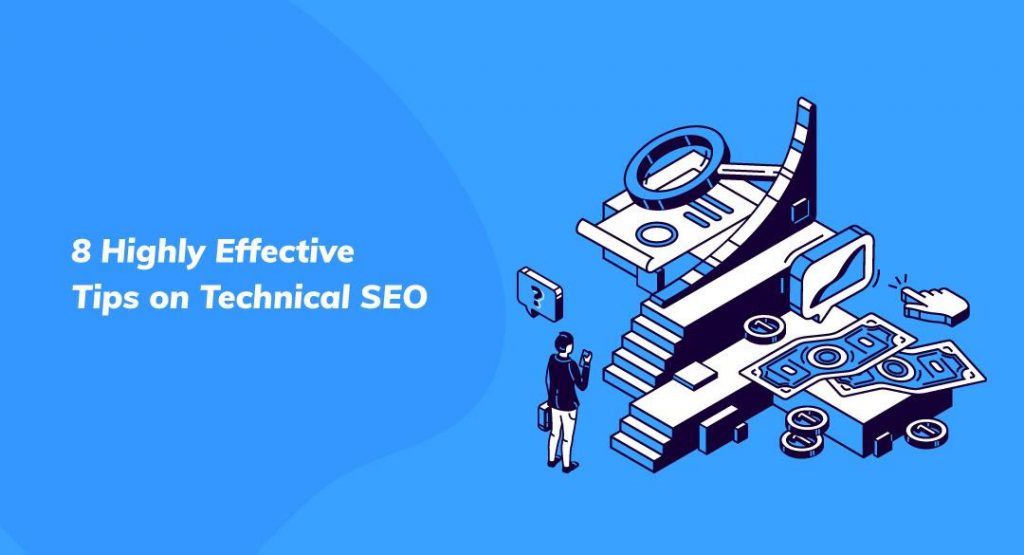Search engine optimization is a set of strategies implemented to improve the quality of websites and increase their search engine rankings on the web. There are three parts of an SEO strategy- on-page optimization, off-page optimization, and technical optimization.
On-page optimization is the process of optimizing web pages to boost their rankings; off-page optimization is the optimization that takes place beyond a website’s web pages. Technical SEO is optimizing websites for technical issues or errors and improving their search visibility.
Many webmasters are concerned about fixing the on-page and off-page elements of their site but fail to give enough importance to their technical SEO strategy. Technical SEO plays a vital role in keeping a website functioning and ensuring that the web pages are crawled and indexed regularly.
Why Does Technical SEO Matter?
Contrary to popular belief, ranking websites in the SERPs is no longer dependent on SEO optimization alone. Search engines consider hundreds of factors before ranking web pages, one of which is user experience (UX).
While search engines have improved at crawling and indexing content better, they cannot do it with utmost perfection to date. Therefore, at times, it is hard for them to figure out what your website is about or whether it has the information searchers are looking for.
Creating quality content doesn’t matter if there’s no way to discover it on the web. Technical SEO optimization helps in fixing such errors and refining the user experience. Hence, webmasters should focus on optimizing the technical elements on their site.
8 Highly Effective Tips on Technical SEO
Listed below are eight highly effective technical SEO tips that must be implemented by every website.

Ensure that your website is mobile-friendly
The primary reason you need to optimize your website for mobile devices is that more than half of the online traffic comes from it. When your site is mobile-friendly, you can expect better conversions. It also offers you a competitive edge over your competitors who are yet to adapt to this feature.
With Google rolling out mobile-first indexing in 2018, it has become even more important for webmasters to work on the mobile version of their websites. This ensures that their content is crawled and indexed better and faster. Moreover, the mobile-friendliness of a website is a ranking factor considered by Google.
To make a website mobile-friendly, you need to ensure that it has a responsive design. Additionally, you have to ensure that your site has a clean user interface, where the texts and images are easy to understand. The CTA buttons should also be large enough for people to click with ease.
You must eliminate any elements that may prevent people from browsing your site, such as pop-ups. You should conduct regular testing to ensure that people are enjoying a seamless mobile experience on your website.
Speed Up Your Website
A slow loading site can have a negative impact on your web traffic and affect your site revenue. You can determine the page speed of your website using the Google PageSpeed Insights tool.
It is said that if your site takes more than three seconds to load, the bounce rate rises by 32%.
Google has already indicated that page speed is one of the factors that influence rankings in the SERP. If your website is slow, it will automatically pull down your organic ranking. Therefore, you must optimize your site for page speed by adopting the best practices.
For this, you need to compress the size of your Javascript, CSS, and HTML files. You should also optimize images on your site to reduce their file size without compromising on their quality.
Reducing the number of redirects on the site, improving server response time, using a content delivery network (CDN), and leveraging browser caching are few other ways to ensure that your site content loads fast.
[Ebook] Technical SEO for non-technical thinkers
Install an SSL Certification
SSL protects sensitive data on the web as it travels across computer networks. SSL certification is vital for all sites, especially the ones that deal with monetary transactions.
As users share their credit card or debit card information, usernames, and passwords, the SSL encryption ensures that the personal data is only accessible to the server you’re sending to.
Any website with an SSL certification proves that it is authentic, and users are safe from online phishing and vishing attacks. An SSL or TLS certification also helps to build trust in customers and increase the traffic. Moreover, SSL certification, AKA HTTPs encryption, is a ranking factor, as announced by Google in 2014.
Google has now made it mandatory for websites to have an SSL/TLS certificate installed, failing to which it will warn users with a “Not Secure” message on the URL bar.
Find and Fix Broken Links on Your Website
Broken links not only hamper the user experience on a website but also sends negative signals to search engines. When people leave your site midway due to broken links, Google assumes that it does not offer a good user experience and affects your website ranking.
Webmasters should find out broken internal and external links within their site and fix them at the earliest. Without fixing them, you are blocking the road to successful conversions. It might also prevent people from revisiting your site and question your site’s credibility.
So, audit your website at regular intervals and check for broken links using free SEO tools available on the web. Once you detect broken links, you can either redirect them to a similar web page or remove them altogether.
Use Canonical URLs to Avoid Duplicate Content
A canonical tag is used to notify search engines which version of the URLs with duplicate content you want to appear in the search results. It is indicated using the rel=”canonical” command and it helps to fix duplicate content issues on the web.
The duplicate content issue may arise when search engine crawlers reach a web page through different URLs, such as http://www.example.com and https://www.example.com. For you, these URLs represent a single page, but for a search crawler, these are two unique web pages.
Many sites automatically create multiple URL paths to the same content and develop duplicate content issues with webmasters realizing it. Homepage duplication is a prevalent issue on the web. To fix it, designate web pages with canonical tags so that search engines know which version to consider for ranking.
Describe the Image Alt Text
The alt-text is short of alternative text, which is used to describe an image on a web page. When image files cannot be loaded, the alt text appears to describe the image. Moreover, alt text helps search engine crawlers understand the context of an image in relation to the web content and index it better.
Your Alt text should be descriptive enough to tell what the image is about. Don’t keep your Alt text more than 125 characters. You can include your primary/target keyword or a long-tail keyword within your Alt text only if it can be placed naturally.
Avoid stuffing keywords in all the image Alt text to avoid getting penalized by Google. Describing image Alt text is also beneficial for visually impaired individuals browsing your web pages using screen-reading tools.
Fix Crawl Errors
Crawl errors occur when search engine bots fail to reach a website. Fixing crawl errors is one of the major technical SEO fixes that webmasters have to deal with. Due to crawl errors, any new content that you publish on your site will not be indexed by search engines, and it may not appear in the search results.
Crawl errors can happen due to many reasons. You can use free tools like Google Search Console to detect the type of crawl error faced by your site and fix them immediately.
Some crawl errors can commonly occur due to temporary DNS errors that prevent a search engine from communicating with the server for some time. Server errors occur when there are flaws in your site code or when the number of visitors on your site is more than the server could handle.
Google bots try to crawl the robot.txt file to detect areas on your websites that have not been crawled yet. In the absence of the robot.txt files, Google postpones the crawl or shows web pages that you don’t want to show in the search results. So ensure that your robot.txt files are always available.
URL errors occur when individual web pages cannot be crawled from your website. 404 or Page Not Found is a common URL error that can be fixed by redirecting invalid URLs or changing the sitemap entries and internal links.
Create XML Sitemaps
XML sitemaps act like a roadmap for Google to access all your important web pages. If you have web pages with no internal links pointing towards them, it can get hard for Google Bots to crawl them. However, with an XML sitemap, you can list all your site’s important pages.
Besides, the XML sitemap also helps search engines to understand your site structure better. If you have a WordPress website, you can create an XML sitemap for your site using the Yoast SEO plugin.
If you observe an XML sitemap by Yoast, you’ll find a date at the end of each line listed in it. It notifies Google when your web content was last updated. Whenever the date changes in the XML sitemap, Google understands that there is new content to crawl and index. Therefore, by creating XML sitemaps, you are making it easier for Google to crawl your site effectively.
Conclusion
Technical SEO in 2020 is about streamlining technical aspects of a website with on-page and off-page SEO efforts to ensure maximum visibility in the search engines and better ranking in the SERPs. So ensure that you are implementing the best SEO practices for your website.

